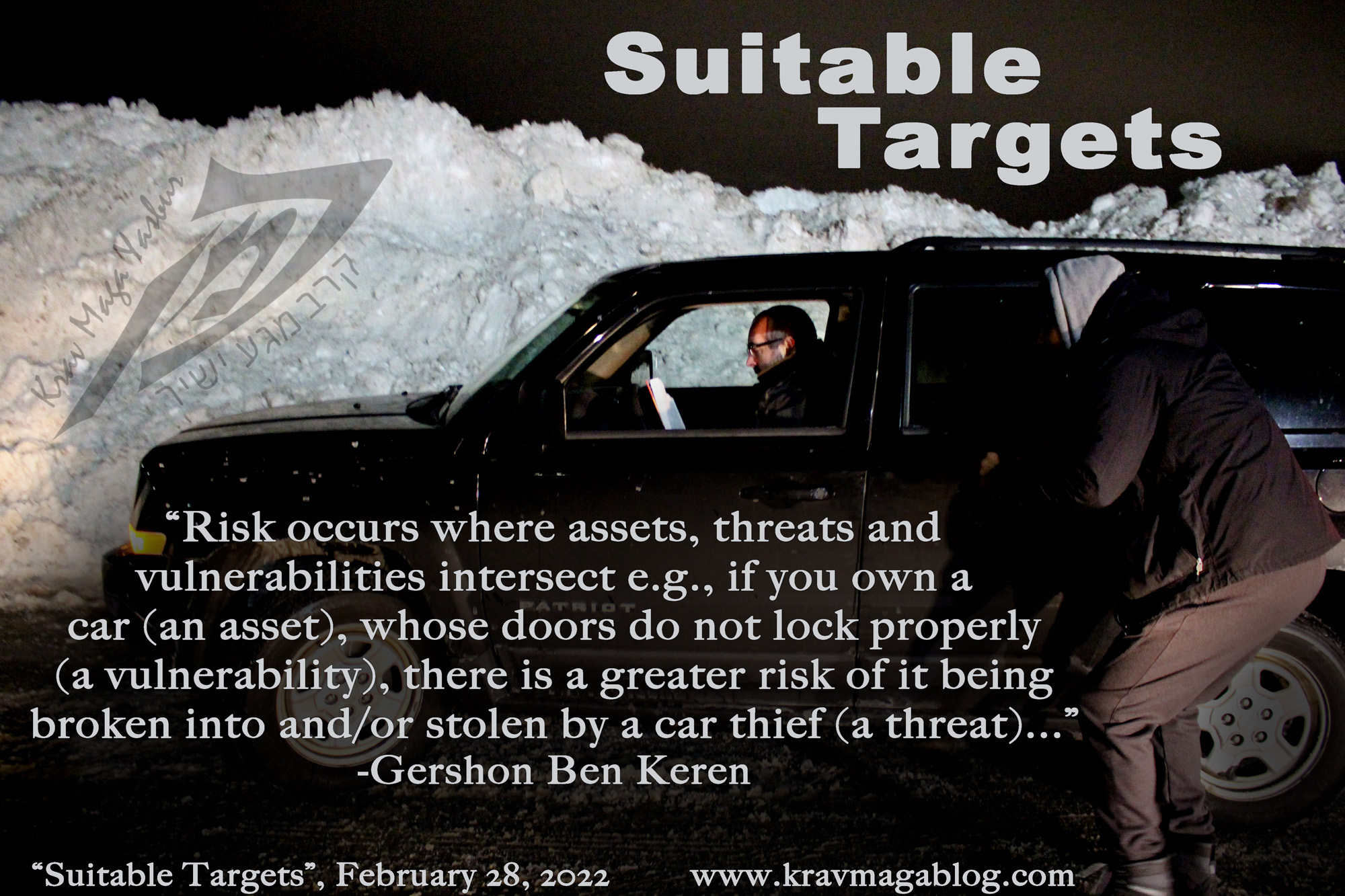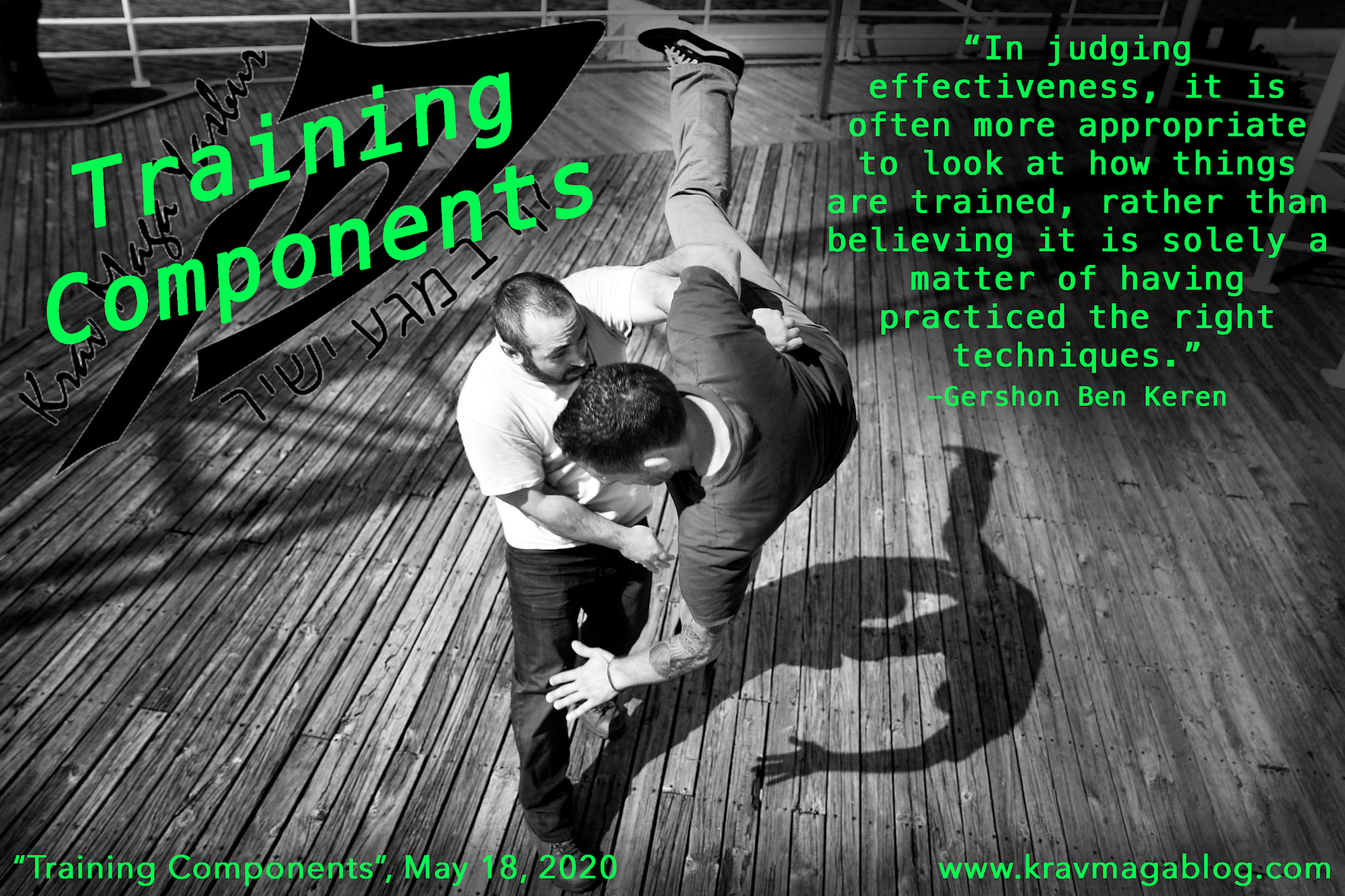Training Components, is an article written by Gershon Ben Keren, a 5th Degree Black Belt in Krav Maga, who teaches Krav Maga in Boston, MA. He has also authored three Amazon best-Selling Books on Krav Maga.
In Reality-Based Self-Defense, techniques are often presented as the great equalizers. After a professional MMA fighter, professed difficulties in dealing with a burglar he got into a fight with in his home, in the early hours of the morning, there were many who were quick to comment, “if only he’d known Krav Maga”; that somehow what a professional, fulltime fighter/athlete was lacking were the right techniques, and that this alone would have made the difference. This is an extremely dangerous fallacy, which unfortunately is extremely common in many martial arts and self-defense circles. If you believe that you would have fared better, because you train two, one hour sessions a week, practicing the “right” techniques, your understanding of what it takes to deal with real life violence is flawed. When I first started working door and bar security, I was training roughly 6 hours a day, lifting, running, sparring, etc., and still, a physical encounter would rarely be easy; unless the punter was so drunk, he could barely stand. It is not uncommon to read on social media that traditional martial arts such as Judo and Karate do not work in reality, etc. These were the systems, that we trained in back then, and they worked for us – it really doesn’t matter what system you train in e.g. a good punch is a good punch, whether you’re a boxer, a karateka, or a Krav Maga practitioner. In judging effectiveness, it is often more appropriate to look at how things are trained, rather than believing it is solely a matter of having practiced the right techniques. Below are five training components I believe are necessary to deal with real world violence, and unfortunately looking at the way Krav Maga is often presented and trained, the MMA guys have more of these covered. I’ve written about these things individually before, but I thought it may be worth bringing them together in one place/article.
Skill Building: Skills rather than techniques make you successful in real-life confrontations. Rather than accumulating techniques, your time is best spent developing fighting skills. Being able to move effectively, stay on your feet, deliver power through your striking, etc., is far more important than knowing “how” to deal with a rear strangle, a guillotine choke, etc. Without these basic skills, you will either find yourself in situations you could have possibly avoided (such as being in a guillotine choke, or rear strangulation, etc.), or won’t have the ability to solve the problem that you’re facing. As a competitive Judoka, who has had to deal with rear strangles, in a “sport” context - not a real-life situation - people will really sink them in; when there are medals at stake I would make the argument that people will be as determined and fight as hard as they would in real life. It’s not knowing the “correct” technique that deals with this issue, it’s having a set of fighting skills that allow you to do so; an effective technique helps, but it’s not the solution.
Taking a Multi-Phased Approach to training: Just because you can escape from a rear strangle or guillotine effectively – because you have the skillset to do so, and a technique that is effective – doesn’t mean that the fight is over. In most cases, you’re back to a point where you’re equal/even to your attacker; and they’ll start attacking again. Getting caught in a Guillotine or Rear Strangle, that you have to get out of, means that something has gone wrong with your “game plan”, escaping really gets you back to zero, and you need to start again from there. Attacker’s don’t stop their attacks, because you’ve dealt with one of them; they keep attacking. Fights are multi-phased and multi-dimensional. That is, they can start at range with striking, move to grappling, go to the ground, get up from the ground, and go back to striking. The idea of escaping and disengaging is great, but it’s not always possible and often a fight ends up as a back-and-forth, and hopefully you improve your situation bit by bit, rather than perform a technique that always works, and is followed up with a series of strikes that allow you to “end” the fight.
Dynamic Training & Realistic Range: When somebody tries to stab you with a knife, they’re not usually static, but moving with the weapon, as they repeat their attacks. As you move to deal with them, they move to deal with you, etc. This is the nature of a fight. In a large number of such attacks, the other arm is used to grab, push, pull and/or drive, which means that such attacks are going to be initiated within the length of am arm. However, often defenses against such attacks, are practiced at ranges and distances where a marching band could have been placed between the attacker and target; often to allow a “technique” to work optimally. There is nothing wrong starting training techniques at these ranges to allow a student a level of success, but the goal should be to shrink these distances down over time. There is also nothing wrong with practicing defenses statically, but at some point you need to be practicing dynamically e.g. having an attacker with a knife, driving you backwards with their forearm across your throat, etc.
Scenario/Context Based: Reality-based training should reflect reality e.g. when was the last time you saw a fight initiated with a two-handed choke? Such attacks tend to occur in extremely specific contexts, they are not experienced universally. This should be explained. Not doing so gives individuals the wrong idea of what violence looks like and doesn’t prepare them for reality. If you simply train a technique like a rear-strangle defense without a context, an individual may be under the impression that it is common for assailants to simply come up behind them and start to strangle them – and if this isn’t trained dynamically where balance is taken, and students are forcefully dragged back, then people may start to believe that such attacks occur statically. In looking at context, an important question concerning an attack is “why” i.e. why would somebody apply a rear-strangle on somebody else? If the answers start to resemble something from one of the Jason Bourne movies, it may be time to reevaluate what you emphasize, and restructure your syllabus.
Stress & Exhaustion: Fighting (Self-Defense is simply the legal justification to fight), is exhausting and stressful – competitive fighting is the same in this regard, though the stressors are different. Krav Maga gets this, and certainly the Israelis do; the UZI SMG was designed around the premise that an exhausted soldier could reload it whilst moving - an understanding that combat is dynamic, consists of multiple phases and is exhausting/stressful. The higher your skill levels and fitness, the less that this factor will affect you. However, fitness isn’t a substitute for skills, and skills aren’t a substitute for fitness, and whilst an aggressive mindset is key to being successful in a fight, if you’re dealing with somebody who is equally aggressive (and in my experience many people will match you on this), it’s usually your skills and fitness that make the difference. However, if you don’t train these in an exhausted and stressed state, you won’t have a reference point to work from when it comes time to do it for real.
Creating safe training programs that meet these requirements can be challenging e.g. exhausted people often lack control, and extreme stress can be psychologically harmful – I heard of one Krav Maga school subjecting students to water-boarding, which is wholly irresponsible, and misses the point of self-defense training completely i.e. what is the context? However, training for reality, must reflect reality in order for it to be effective, and all of the components necessary to be successful need to be trained.
0 COMMENTS














